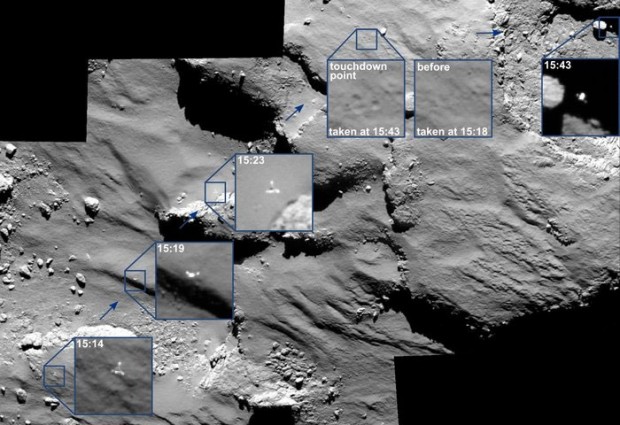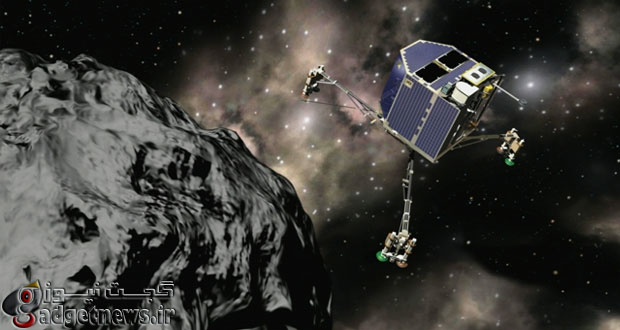اواخر هفته گذشته کاوشگر “فیله” تاریخ ساز شد و برای نخستین بار دستگاهی ساخت بشر بر روی یک دنباله دار فرود آمد. اما این عملیات بدون مشکل نیز نبود و اگرچه این کاوشگر توانست قبل از اتمام باتریاش عملیات دریل، تحلیل خاک و ارسال داده به زمین را با موفقیت انجام دهد، ولی فیله حدود 100 متر دورتر از محل مورد نظر اولیه فرود آمد.
دلیل این اتفاق، عمل نکردن دو لنگری بود که از قبل برای محکم کردن آن بر روی سطح دنباله دار 67پی در نظر گرفته شده بود. عدم فعال شدن این لنگرها سبب شد که فیله همزمان با حرکات دنباله دار و عدم وجود جاذبه کافی، چند بار در هوا معلق شده و در نهایت در زیر یک صخره جا خوش کند.
جاگیری در زیر صخره ای که دارای سایه بود، عاملی برای کاهش شدید نور دریافتی توسط پنل های خورشیدی کاوشگر شد تا عملا امکان شارژ مجدد دستگاه (پس از از بین رفتن انرژی باتری) امکان پذیر نباشد.
با این حال تنها کسی که توانست تصاویری بسیار خوب از این لحظات دلهره آور را به ثبت برساند، فضاپیمای مادر یعنی روزتا بود. روزتا طی این جابهجاییهای سنگین ، تصاویری بسیار خوب از کاوشگر فیله را در تمامی لحظات فرود اولیه، معلق شدن و فرود نهایی به ثبت رساند.

جزئیات فرود و برخوردهای فیله با سطح دنباله دار را با ذکر ساعت در تصویر بالا مشاهده می کنید. ( برای مشاهده تصویر در ابعاد اصلی بر روی آن کلیک کنید )
تمامی این تصاویر به وسیله یکی از سیستمهای پر استفاده روزتا به نام OSIRIS گرفته شده است.
منبع : ESA
OSIRIS spots Philae drifting across the comet
OSIRIS spots Philae drifting across the comet
These incredible images show the breathtaking journey of Rosetta’s Philae lander as it approached and then rebounded from its first touchdown on Comet 67P/Churyumov–Gerasimenko on 12 November 2014.
The mosaic comprises a series of images captured by Rosetta’s OSIRIS camera over a 30 minute period spanning the first touchdown. The time of each of image is marked on the corresponding insets and is in GMT. A comparison of the touchdown area shortly before and after first contact with the surface is also provided.
The images were taken with Rosetta’s OSIRIS narrow-angle camera when the spacecraft was 17.5 km from the comet centre, or roughly 15.5 km from the surface. They have a resolution of 28 cm/pixel and the enlarged insets are 17 x 17 m.
From left to right, the images show Philae descending towards and across the comet before touchdown. The image taken after touchdown, at 15:43 GMT, confirms that the lander was moving east, as first suggested by the data returned by the CONSERT experiment, and at a speed of about 0.5 m/s.
The final location of Philae is still not known, but after touching down and bouncing again at 17:25 GMT, it reached there at 17:32 GMT. The imaging team is confident that combining the CONSERT ranging data with OSIRIS and navcam images from the orbiter and images from near the surface and on it from Philae’s ROLIS and CIVA cameras will soon reveal the lander’s whereabouts.
The insets are provided separately via the blog: OSIRIS spots Philae drifting across the comet
Credit: ESA/Rosetta/MPS for OSIRIS Team MPS/UPD/LAM/IAA/SSO/INTA/UPM/DASP/IDA
 گجت نیوز آخرین اخبار تکنولوژی، علم و خودرو
گجت نیوز آخرین اخبار تکنولوژی، علم و خودرو 






